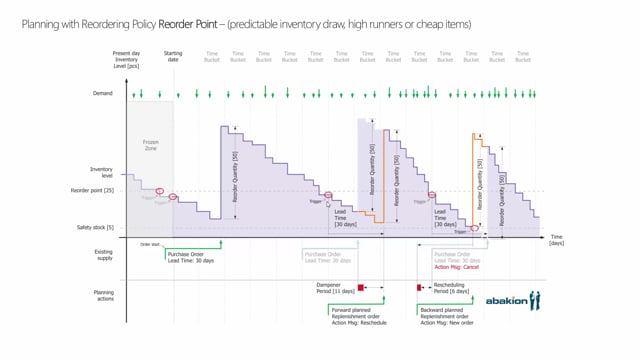
How does the dampener period, rescheduling period and the time bucket on items work in Business Central?
I will give a short overview of the fields dampener period on the item card and the SKU card, the rescheduling period down here and the time bucket and be aware here, the time bucket only relates to reorder point parameters whereas the rescheduling period relates to lot for lot parameters and the dampener period relates to all of them or both of them, even also to order like you can see here.
This is what happens in the video
So the field is still active and what I’ll do is to explain this with a small drawing and I will mix the two a little together to give you an overview of the understanding of the fields. So let’s take an example.
The example is we have some demand. Those are the previous demand from present-day and we just assume in the beginning it’s a reorder point item. I’ll change that in the end of that example, and maybe the previous existing supply are three purchase orders. They are here with a lead time of 30 days and they’re already in the system, but the supply has changed since last time we ran the planning worksheet so we will expect something to happen.
Those are the expected inventory with the new demand and the existing orders. So this is what we put into the planning engine, and already here we can see there will be some safety stock breaches, Etc.
We have a reorder point if it’s a fixed quantity item, that is the safety stock and there’s a starting date meaning, we also have a frozen zone and let’s see how the planning works and how those fields gets taken into account. So first of all, the triggers and the frozen zone won’t do a lot of stuff but the planning will plan into time buckets, and that’s the first field on the item card.
So it divides all the demands into time buckets and plan on the start of each time bucket. Meaning, the first time we have a true trigger point is here because we get below reorder point before that period in that time bucket and therefore it will capture the reorder point on the start of next time bucket.
This is meant to create less planning line that creates changes. So if I plan on each time bucket start, it’s easier for me to use fixed reorder point because it’s not that critical that I get the item on an exact time.
So in this example, we would need to move those purchase order from where it is now until that trigger point.
So there’s a dampener period which is now exceeded.
So the dampener on the item card is set up to be less than the 11-day. It should move the order and therefore it actually reschedules the order in the planning journal but if the dampener period has been more than 11 days and we didn’t have a safety stock breach, it will not suggest to move the order so we wouldn’t have this action in the planning worksheet.
So the dampener period is a buffer to handle whether or not to move the items. in the next example, basically the example is the same. We have the reorder point. We have a trigger on safety stock in this example, so it should create a backward plant purchase order instead. And we’ll use lot for lot.
And now it’s the example where it’s not reorder point but lot for lot and it looks at the rescheduling period, and if it’s within the rescheduling period, the time it needs to move, it will have rescheduled the existing order if it’s more than the rescheduling period like in this example, it will cancel the purchase order and suggest to make a new order.
So the rescheduling period and the dampener has to do with whether to move orders, whether to rescheduling or to cancel them and create new orders. So that’s how those filters are used.

